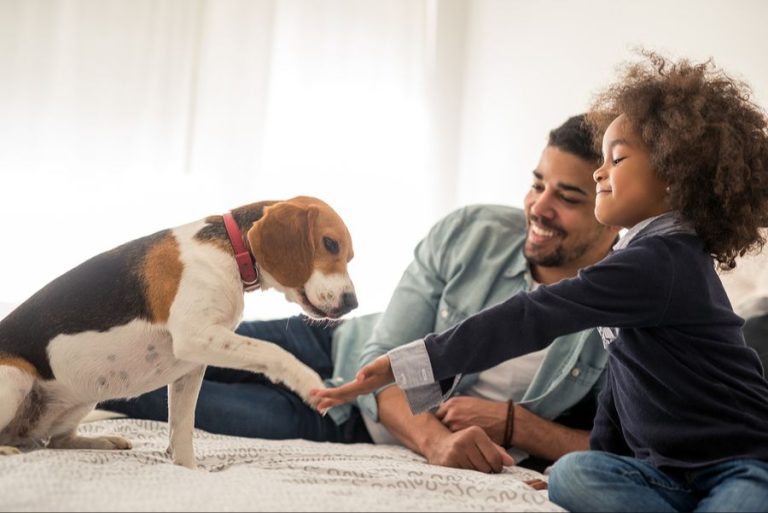Teaching Your Dog To Relax On Command: Stress Reduction Techniques
Teaching dogs to relax on command can provide numerous benefits for both dogs and their owners. Relaxation training helps dogs learn to control their impulses, settle down when overexcited, and remain calm in stressful situations (VCA Animal Hospitals). For pet parents, having a dog that can relax on cue makes living together harmonious and pleasant. Overall, relaxation training improves a dog’s behavior both inside the home and out in public. It also strengthens the human-canine bond through clear communication and mutual understanding.
Understanding Dog Stress
Dogs can experience stress from a variety of sources. Some of the most common causes of stress in dogs include:
- Loud noises like fireworks, thunder, or construction sounds (Source)
- Being left alone or separated from their owners (Source)
- Introduction to new environments, people, or other animals (Source)
- Changes in routine or environment like moving homes (Source)
- Lack of exercise or mental stimulation
- Illness or pain
Dogs that experience frequent or prolonged stress may develop anxiety disorders or other behavioral issues. It’s important for owners to recognize common stress triggers and learn techniques to help dogs relax.
Observing Stress Signals
Dogs exhibit both behavioral and physical signs when they are feeling stressed. According to the VCA Hospitals (source), some of the most common observable signals of stress in dogs include:
- Panting – Rapid, shallow breathing often with the tongue curled.
- Pacing – Repetitive walking back and forth.
- Whining – High-pitched vocalizations.
- Lip licking – Repeatedly licking lips and snout.
- Yawning – Frequent yawning when not tired.

Other signs to look out for according to Blue Cross (source) include dilated pupils, blinking rapidly, ears back, trembling, and hiding. By recognizing these behavioral and physical changes, you can better understand when your dog is becoming stressed.
Preventing Stress Build Up
Preventing your dog from getting stressed in the first place is crucial to their overall wellbeing. There are several key things you can do to help avoid stress build up:
Exercise is extremely important for relieving stress in dogs. Going for regular walks, playing fetch, or visiting a dog park allows your dog to release pent up energy and tension (source). Try to exercise your dog for at least 30-60 minutes per day.
Providing enrichment through toys, chews, food puzzles, and activities prevents boredom which can lead to stress. Rotate different toys to keep things interesting and give your dog mental stimulation (source).
Following a predictable routine gives your dog a sense of control. Feed, walk, and play with your dog at consistent times each day. Consistency and structure is calming for dogs.
Training Prerequisites
Before attempting to teach your dog to relax on command, it’s important that your dog has mastered some basic obedience skills. According to the Calm Canine Academy, having control over your dog’s basic behaviors is a prerequisite for relaxation training
Your dog should reliably respond to commands like “sit,” “down,” “stay,” and “come” before relaxation training begins. If your dog doesn’t obey these commands, the training sessions will become frustrating for both you and your dog. Spend time reinforcing basic obedience before moving on to relaxation skills.
Additionally, having a solid “release” command is a must. The release command allows your dog to break their settle once asked. This command gives your dog permission to stop the extended down-stay required in relaxation. The Impulse Control guide recommends “OK” or “free” for the release cue.
Mastering basic obedience and having a tried and true release command sets you and your dog up for success in relaxation training. Taking the time to cement these preparatory skills will prevent frustration and confusion during the settle training process.
Setting Up Training Sessions
It’s important to set your dog up for success during relaxation training by starting in a low distraction environment. This could be inside your home or fenced yard, avoiding areas with a lot of foot traffic or noise. Make sure your dog has access to their mat, bed, or another comfortable area to settle on. Having high-value food rewards on hand will also help reinforce the desired settling behavior. According to Calm Canine Academy, starting relaxation training in an area free of major distractions helps your dog focus on the cues and develops good habits from the beginning.
Work in short 5-10 minute training sessions initially as your dog is learning this new skill. Gradually increase to longer durations as they become proficient at settling on cue. Keep sessions positive throughout. If your dog has trouble relaxing in a particular session, take note and try again later when they may be more receptive.
Teaching Settle
Teaching your dog to settle on command involves capturing calm behavior and rewarding duration over time. Start by waiting for your dog to lie down and relax on their own. The moment they do, say “settle” and give them a treat. Repeat this several times to associate the cue word with the desired behavior. According to the DDFL, “Start with a two- to three-second settle and work up to five minutes or so. For dogs under six months of age, a two- to three-minute settle is long enough.”
As your dog starts to understand the behavior, gradually expect longer durations before rewarding with a treat. Maddie’s Fund recommends to “Stay calm and ignore your dog and wait for them to settle, and eventually they will lie down. When they do, praise and reward them with a treat. Continue to reward calm behavior and the time duration will naturally increase.” The key is being patient and rewarding calmness. Eventually your dog will relax for longer periods when given the “settle” cue.
Generalizing the Behavior
Once your dog has mastered settling on cue in a quiet room without distractions, the next step is to generalize the behavior by practicing in different locations and with distractions present. The goal is for your dog to settle in any environment when given the cue, regardless of what’s going on around them.
Start by moving the training to a slightly more distracting area of your home, like the kitchen or living room. Have your dog go through the settling routine with you nearby. Gradually add minor distractions like toys, treats, or sounds while asking for the settle behavior. Reward calmness and lack of interest in the distractions.
After home environments, practice in outside areas like the backyard, then move to public spaces like parks. Vary the location often so your dog learns to settle anywhere on cue. Exposure to sights, sounds and smells in the area can be incorporated as distractions. Always keep sessions short when adding new challenges.
The key is to progress slowly so you don’t overwhelm your dog. If they struggle, dial back the difficulty level and build skills over multiple sessions before trying again. Consistent training will reinforce that “settle” means to relax, no matter the environment.
According to this article, randomizing when and where you practice creates the best generalization. So mix up the location and distractions rather than progressing through them sequentially.
Troubleshooting
For dogs that struggle to settle or break the settle command due to high arousal, here are some tips:
- Make sure your training sessions are low distraction at first. Gradually increase distraction over multiple sessions once the settle behavior is reliable in an easy environment (per this source).
- If your dog breaks the settle command, don’t yell or punish them. Remain calm and re-cue the settle command in a neutral tone (per this source).
- Consider whether your dog is getting enough physical and mental exercise. A dog with pent up energy will have a harder time settling. Make sure exercise needs are met.
- Work on impulse control games during other training sessions. This can improve your dog’s overall ability to control their impulses.
- Use high value rewards when they successfully settle and ignore unwanted behavior. This reinforces calm behavior.
With patience and consistency using these tips, you can troubleshoot problems with highly aroused dogs. Continue rewarding and practicing the settle command in various environments.
Conclusion
Teaching your dog to settle on command provides numerous benefits. A strong settle command helps your dog learn to relax and reduces overall stress and anxiety. This can lead to a calmer demeanor and prevent problem behaviors that stem from a lack of impulse control. Dogs with a solid settle command tend to be better behaved in exciting situations, such as when greeting people at the door or seeing other dogs on walks. They can relax on cue rather than reacting hyperactively. A settle command also gives you a way to quickly get your dog to calm down and refocus when needed. This is invaluable for reducing chaos and frustration in your home. Overall, teaching this skill provides a lifelong gift to your dog by giving them an outlet to relieve stress and maintain composure. Both you and your dog will be happier with this command mastered.






